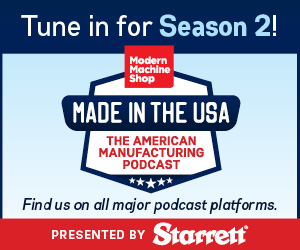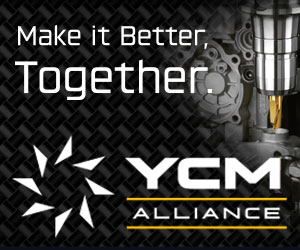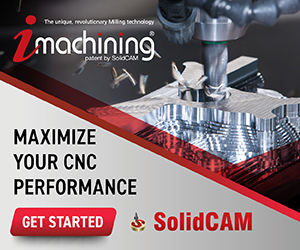The New Rules of Cutting Tools — Rule #1: Do More With Your Machine
Sponsored ContentThe tooling has the potential to transform the process.
Share
The most common reason why machine shops switch from one tool to a different tool is to improve tool life.
If the new tool performs longer in the existing process, then it can save money for the shop—money for the cost of replacement tools and money for the labor involved in performing so many tool replacements.
More aggressive machine shops also adopt new cutting tools in order to increase their speed. If the new tool can perform well in an accelerated process that involves significantly higher metal removal rates, then the tool saves the shop money in an even more significant way. That is, the tool can effectively increase the shop’s capacity by allowing it to run more parts per shift.
Both of these process improvements—life and speed—represent important returns on investment, and important reasons to adopt high-performance tooling.
However, the search for ways that the cutting tool can improve the process should not stop here, because there is potentially so much more savings to be realized. Shops committed to improving their machining capabilities need to look to the various ways that advanced tooling can not only extend or accelerate the machining process, but also transform it.
The Power Of Drilling
Precision Dormer product manager Andrew Hunter points to a seemingly simple but tremendously underappreciated example of transformative tooling. Specifically, he points to the state of today’s precision drill technology.
In many hole machining applications today, he says, it is no longer necessary to ream. Drills today can be cost-effectively manufactured to tighter quality standards than ever before, potentially allowing the shop to achieve the necessary hole accuracy and quality requirements through drilling alone. In many machining facilities, however, the hole machining process of center drill, drill and ream can be so familiar that it can be difficult to identify this sequence as a source of unnecessary expense.
Precision Dormer routinely advises shops on where reaming might not be necessary. A change in cutting parameters with a drill roughly equivalent to what the shop is already using may produce the requisite quality hole. If not, Precision Dormer can help the shop quickly find and evaluate another drill that is likely to perform better. Even if the new tool is slightly more expensive, the added cost will be small compared to the savings resulting from eliminating an unnecessary tool from the process, as well as removing an unneeded toolchange from the machining cycle.
Other Process Changes
Bill Tisdall, development specialist manager for Sandvik Coromant, is involved in testing and refining most of the company’s new tooling designs. He sees a number of other ways that tooling technology can enhance productivity through fundamental change. He urges shops to think about all of these potential benefits of using the right tool:
■ Take advantage of machine tool features. Is your tooling doing all that it can to harness the technology improvements that are becoming more common in machine tools today?
An important example of more commonplace machine tool technology is the prevalence of high-pressure coolant in the newest machines. Too few shops have the tooling that would let them take full advantage of the 70-bar coolant supply its machines may now have available.
Sandvik Coromant’s CoroTurn HP tooling does harness the power of this pressure. By accurately focusing the high-pressure stream onto a point just above the cutting edge of a turning tool, the CoroTurn HP holder transforms the coolant supply into a wedge, lifting the chip away. In difficult materials such as Inconel 718, tool life can increase by 50 percent or speed can increase by 20 percent.
■ Reduce setup time. The Coromant Capto system from Sandvik Coromant is an industry standard for quick-change tooling in turning. Relying on Coromant Capto can allow replacement tools or tools for new jobs to be quickly locked in place, without having to adjust the tool position or reset tool offsets. The same Coromant Capto concept has been applied to rotary tools as well, so new or replacement milling and drilling tools can also be swapped in and locked into place without any changeover delay.
One other setup reduction system, the company’s QS system, applies to Swiss-type lathes. With QS, tools can be slid in and out quickly, automatically locking into place on center. One owner of a Swiss-type turning shop calculated that the system saved $100,000 per year in setup time on one machine. Based on this finding, it was easy for him to commit to having the rest of his Swiss-type machines equipped with the same system.
■ Run unattended. In addition to life and speed, think about evaluating your cutting tools in terms of their reliability. Not enough shops realize how potentially valuable it can be to depend on tools that provide a high level of performance consistency.
Why is the consistency so valuable? Because it can transform the process in potentially the most profitable way—by sufficiently freeing the operator from the machine that he or she can operate additional machines, inpsect parts or carry out steps related to 5S or other aspects of lean manufacturing while the machine runs. Sandvik Coromant calls this “green-light production.” If the machine shop or machining facility can confidently predict exactly when the tool will need replacement, then the shop can trust its machining process to run in this way, without an operator always having to be present.
Sandvik Coromant’s new GC1125 and GC1515 cutting tool grades are engineered specifically for green-light production. The inserts’ reliability comes from a balance between coating and substrate. The substrate is a little softer to enhance toughness and consistency, while the composition of the coating provides the needed wear resistance.
These tools also offer very sharp edges, which is another important green-light production feature. The sharp edges help eliminate burrs. Eliminating burrs is particularly important for long unattended runs, because the shop that runs this way does not want to have to deal with a large batch of parts all waiting to be deburred when the run is complete.

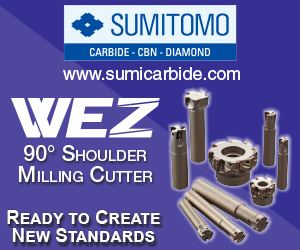
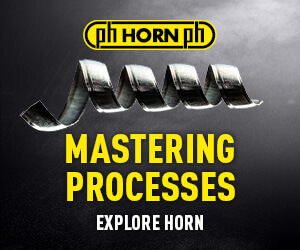

.png)





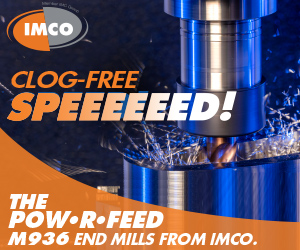
.jpg)
